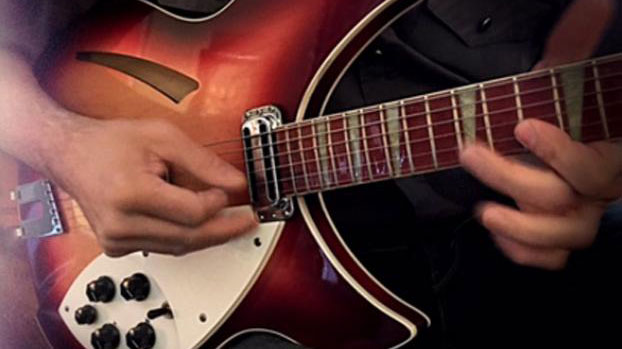Jazz Guitar Chord Exercises
An exercise that uses all the inversions of any chords you're learning, while playing them in a common chord progression at the same time.

One of the most common questions I get from my students and readers is, “I know what jazz chords to study, but how to I practice them in a practical, musical way?”
To help answer this question, I’ve put together an exercise that uses all the inversions of any chords you are learning, while playing them in a common chord progression at the same time.
In this lesson, you will learn how to practice Drop 2 and Drop 3 chords in all inversions, applied to a major ii-V-I chord progression to keep these shapes practical and musical in your woodshedding.
I’ve provided examples for one string set of each chord shape, Drop 2 and 3, but feel free to apply this exercise to any string set your are working on in your jazz guitar studies.
I’ve also written out each example in the key of C, so to take this exercise further, make sure to work these shapes together in all 12 keys around the fretboard in order to get an in-depth understanding of how they lay on the neck of the guitar.
The Jazz Guitar Chord Exercise
The exercise is a fairly straightforward concept, but applying it to the fretboard can take some time and effort in the practice room.
Here is the exercise:
All the latest guitar news, interviews, lessons, reviews, deals and more, direct to your inbox!
- 01.Pick a chord shape such as Drop 2
- 02.Pick a string set, top four strings for example
- 03.Play the root position iim7 chord, such as Dm7
- 04.Move to the closest V7 chord, G7 in this case, without moving your hand if possible
- 05.From there, move to the closest Cmaj7 chord without moving your hand
- 06.Repeat but start on the next inversion of iim7, Dm7 in this key
- 07.Repeat until you’ve covered all four inversions of the iim7 chord and the closest V7 and Imaj7 chords from those four shapes.
That’s it. Pretty simple, but playing and memorizing these shapes in four areas on the neck can take some time in the woodshed. So, let’s take this exercise and see how it lays on the fretboard in the next section of this lesson.
Drop 2 Chord Exercises
Now that you understand what the exercise is, let’s take it to the fretboard, beginning with Drop 2 chords on the top four strings. You will begin with a root position Dm7 chord, moving to the closest G7 chord, and finally landing on the closest Cmaj7 chord from there.
I’ve written the inversion under each chord so you can memorize that movement as well, which will make it easier to transfer this exercise to other string sets and keys in your practicing.

Now, you’ll move on to the first inversion Dm7 chord, with the other chords being as close to that initial chord as possible.

Next, you are playing a second inversion Dm7 chord and following on to the closest G7 and Cmaj7 chords from that initial shape on the fretboard.

Lastly, here is a third inversion Dm7 chord that then leads to the closest G7 and Cmaj7 chords from there.

Drop 3 Chord Exercises
To help you take this exercise to another common jazz chord shape, here are four examples of applying this idea to Drop 3 chords on the 6th-string root groupings.
Again, you can take these shapes to other keys on the sixth-string root, as well as apply them to other string sets for Drop 3 chords as you expand on them in your studies.
To begin, here is a root-position Dm7 chord that then moves to the closest G7 and Cmaj7 chords from there.

Then, you can move on to a first inversion Dm7 chord, which moves to the closest G7 and Cmaj7 from that initial shape.

Following our pattern, the next example uses a second inversion Drop 3 Dm7 chord, which moves to the closest G7 and Cmaj7 chords from there.

And finally, you can start with a third inversion Dm7 chord that moves to the closest G7 and Cmaj7 shapes from that starting point.

Do you have a question or comment about these chord exercises? Share your thoughts in the COMMENTS section below.
Matt Warnock is the owner of mattwarnockguitar.com, a free website that provides hundreds of lessons and resources designed to help guitarists of all experience levels meet their practice and performance goals. Matt lives in the UK, where he is a lecturer in Popular Music Performance at the University of Chester and an examiner for the London College of Music (Registry of Guitar Tutors).
Matt Warnock is the owner of mattwarnockguitar.com, a free website that provides hundreds of lessons and resources designed to help guitarists of all experience levels meet their practice and performance goals. Matt lives in the UK, where he teaches Skype guitar students all over the world, and is an examiner for the London College of Music (Registry of Guitar Tutors).
